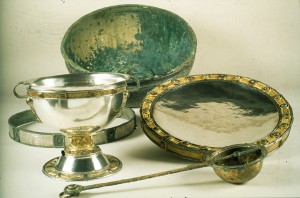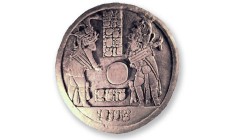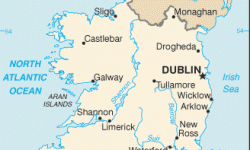Derrynaflan Hoard
Author: Suzie Thomas
Last Modified: 14 Aug 2013

One of the most spectacular hoard discoveries in Ireland, which led first to an increase in enthusiasm for metal detecting as a hobby, but ultimately contributed to the prohibition of unlicensed searching for archaeological material.
On 17 February 1980, Michael Webb and his son, also called Michael, discovered a significant hoard of early church treasure in Derrynaflan, in the townland of Lurgoe, County Tipperary, using metal detectors (Kelly 1994: 213; O’Riordain 1983: 1). The hoard included a chalice, a bronze strainer ladle and a paten (a kind of small plate) (and see Ryan 1983 for a detailed description), and the discovery was described as ‘one of the most exciting events in the history of Irish art’ (Stalley 1990: 186). The large monastic enclosure in which the hoard was found was partially protected as a National Monument (Kelly 1993: 378). The finders reported their discovery to an archaeologist from University College Cork, Dr. Elizabeth Shee Twohig (Kelly, pers. comm., 2012), who advised them that they must take the finds to the National Museum of Ireland in Dublin (Houses of the Oireachtas 1986; O’Riordain 1983: 1). Under Irish law at that time, the finders were entitled to a reward for making the discovery, in this case decided at IR£10,000 (Houses of the Oireachtas 1986), although this was initially rejected by the finders as insufficient compared to the value of the find (Kelly 1994: 213). Six years later, the High Court made a ruling that the find or its value (estimated at IR£5.5 million) should be returned to the finders (Kelly 1994: 113). The public mood turned against the Webbs, who were shown on the main evening television news drinking champagne to celebrate the ruling. Ireland was then in deep recession with massive public service cuts which led to resentment that the Webbs might benefit to the tune of IR£5.5 million from the public purse (Kelly, pers comm., 2012). A year later, in 1987, a further final judgement was delivered by the Supreme Court that the Derrynaflan Hoard in fact belonged to the state and not to the finders (Kelly 1995a). The finders finally received a reward of IR£50,000 (Kelly 1994: 214).
The impact of the case on Irish law concerning the protection of heritage was significant. Debates in the Seánad Éireann (upper house of the Irish Parliament) in 1986 indicate the split in opinions regarding the validity of the claim of the finders to the hoard (as had been decided in court the previous year), with one Senator suggesting that the state should have been trying to prove that the Webbs had no legal claim to the hoard, one Senator regarding such discoveries as no more than looting, and another claiming that the finders should instead be praised for the care with which they removed the hoard from the ground and for going to the National Museum to report the discovery (Houses of the Oireachtas 1986). In 1987 the National Monuments (Amendment) Bill, which included clauses on metal detecting and ancient shipwrecks (another area becoming vulnerable to looting), passed through its final stages in the Dáil Éireann (lower house of the Irish Parliament) (Gosling 1987: 23).
Ireland’s National Monuments Act 1930 had prohibited the excavation of archaeological objects other than under license (Kelly 1995a). However, the maximum fine for a successful prosecution at that time, at IR£10[1], proved not to be a strong deterrent (Kelly 1995b: 235). The discovery of the Derrynaflan Hoard had reputedly contributed to the growth of the metal detecting hobby in Ireland, which by the time of the discovery saw hobbyists searching not only ploughed land and other locations away from archaeological sites, but also on known archaeological sites (Kelly 1993: 378). A 2012 Irish news item, which described an athlete as having ‘more gold than they found in Derrynaflan’ (Keane 2012) indicates that the finding of the hoard is still recalled in Irish popular memory. However, with the National Monuments (Amendment) Act 1987, ‘it became illegal to search for archaeological objects with metal detectors or other electronic detecting devices without license’. A further National Monuments (Amendment) Act 1994 specified the state ownership of archaeological objects, and made it ‘an offence to trade in unreported antiquities, or withhold information about archaeological discoveries’ (Kelly 1995a). Under the 1994 legislation, the maximum penalty was also increased to a fine of IR£50,000 and five years imprisonment (National Monuments (Amendment) Act 1994, Section 13). The National Monuments (Amendment) Act 1987 had been in preparation for many years and so was not a direct reaction solely to the controversy surrounding the hoard (Kelly, pers. comm., 2012), although there were observations made that the upsurge in metal detecting as a result of the discovery led to changes in the law (Kelly 1994: 214).
The Derrynaflan Hoard is on permanent display at the National Museum of Ireland (NMI 2012).
References
Gosling, Paul (1987), ‘An Interim Measure’, Archaeology Ireland, 1 (1), 23-25.
Houses of the Oireachtas (1986), ‘Request Under Standing Order 29: Protection of Archaeological Items’, in Seanad Eireann Debate (ed.), (115; Dublin).
Keane, Billy (2012), ‘Let’s ditch cynicism for a purer, better Games’, Irish Independent, 28 July 2012.
Kelly, Eamonn (1993), ‘Treasure-hunting in Ireland – its rise and fall’, Antiquity, 67 (255), 378-81.
— (1994), ‘Protecting Ireland’s Archaeological Heritage’, International Journal of Cultural Property, 3 (2), 213-26.
— (1995a), ‘Defeating the archaeological looters’, British Archaeology, 4, 8.
— (1995b), ‘Protecting Ireland’s Archaeological Heritage ‘, in Katherine Walker Tubb (ed.), Antiquities Trade or Betrayed: Legal, ethical and conservation issues (London: Archetype and UKIC Archaeology Section), 235-43.
— (2012), ‘re: Derrynaflan Hoard’ [email to S. Thomas], (17 September 2012)
National Monuments (Amendment) Act 1994, available http://www.irishstatutebook.ie/1994/en/act/pub/0017/, accessed 03/06/2013
NMI (2012), ‘The Derrynaflan Hoard’, (updated 2012), available http://www.museum.ie/en/exhibition/list/exhibition-details-treasury.aspx?article=f0c0743d-d43c-49cf-ae40-5f7ebddd34f4, accessed 11/09/2012.
O’Riordain, Breandan (1983), ‘Introduction’, in Michael Ryan (ed.), The Derrynaflan Hoard I: A preliminary account (Dublin: National Museum of Ireland), 1-3.
Ryan, Michael (1983), The Derrynaflan Hoard I: A preliminary account (Dublin: National Museum of Ireland).
Stalley, Roger (1990), ‘The work of Angels’, Irish Arts Review, 1 (1), 186.
[1] Irish pounds were the national currency of Ireland until 2002, when the Euro was adopted.

